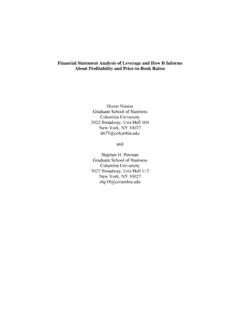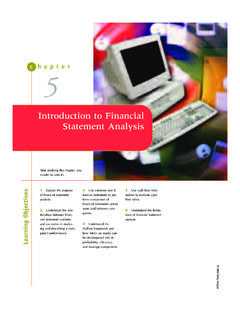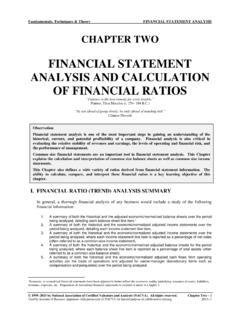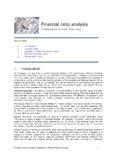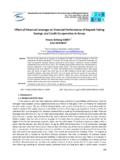Transcription of 7 FINANCIAL ANALYSIS AND INTERPRETATION
1 -.,7 FINANCIAL ANALYSIS ANDINTERPRETATIONI ntroductionSome ProblemsHow to ProceedFinancial Ratios-Sales-Profitability-Asset Management- FINANCIAL Structure-Liquidity Management-Expense AnalysisDuPont s Profitability ModelSources and Uses of FundsPercentage and Trend AnalysisComparative AnalysisFundamental AnalysisSummaryIntroductionFinancial ANALYSIS is the process of taking accounting and other FINANCIAL data andorganising them into a form which reveals a firm s strengths and weaknesses. Byhighlighting these areas, the users of FINANCIAL information can then make moreinformed decisions about the ANALYSIS undertaken will depend upon the needs of the user. If a supplier wantsto know if their bills will be paid, emphasis will be placed on the liquidity part ofthe ANALYSIS . If a banker is being asked for a loan, liquidity and level of debt will beexamined.
2 Equity investors will require a more in-depth ANALYSIS into the Management and Decision Makingsoundness of the investment. The general manager wants to keep track of operatingexpenses, cost of goods, and other operational details of the company. One of themost difficult issues in FINANCIAL ANALYSIS is focusing on the information which hasmeaning for a specific use without becoming lost in unrelated and inappropriatedata and ProblemsThe accounting and FINANCIAL data utilised in the analyses may have their owninherent difficulties and limitations which the ANALYSIS may not uncover. Forexample, the concept of depreciation has been discussed earlier. When undertakingfinancial ANALYSIS it is important to understand the method of depreciation. Aprofitability ANALYSIS using an Income Statement with straight line depreciation willnot yield the same results as an ANALYSIS of data which use the declining balancemethod.
3 Income recognition, inventory valuation, fixed asset valuation, treatmentof work in progress, provisions for bad debts, and treatment of foreign exchangeprofits (losses) are but a few examples of how one ANALYSIS technique would yielddifferent results on the same economic performance depending on how theseaccounting issues were treated. It is therefore important that the accountingmethodology used in compiling the FINANCIAL statements is two companies, A and B, both of the same size (in total assets). It ispossible that company A, with $.90m in current assets available to pay currentliabilities, is more liquid than company B with $ For example, company Amight have reduced its accounts receivable by 20% to allow for uncollectable billsand written down old inventory items to a realistic market price.
4 Company B, onthe other hand, might never adjust their receivables for bad debts and always holdinventory at cost , the accounting profession maintains standards for ensuring thatcompanies within the same industry use the same accounting methods. However, ashas already been discussed in other chapters, not all transactions fit neatly into theaccounting standards. Judgment on the part of the accountant and the manager thenplay a more significant part. When using in-house data for ANALYSIS , it is morelikely that the analyst will know how the data were compiled and will be able tomake adjustments for any limitations in the collection techniques. An externalanalyst does not have this to ProceedThere is no magic formula as to a correct or proper ANALYSIS . Thus, beforecarrying out any FINANCIAL ANALYSIS , a clear statement of the needs and objectives ofthe user must be underlying purpose of FINANCIAL ANALYSIS is to organise a firm s financialstatements and other accounting data into a format that enables comparisons to bemade with other firms and which also enables the raw data to be accuratelyevaluated.
5 There are many approaches to FINANCIAL ANALYSIS but the more commonand widely used include: FINANCIAL ratios, DuPont s profitability model, sources anduses of funds, percentage and trend ANALYSIS , comparative ANALYSIS , and 7: FINANCIAL ANALYSIS and Interpretation111analysis. These ANALYSIS techniques are examined below, while at the same timeacknowledging the problems and limitations of the input RatiosA large number of FINANCIAL ratios can be created to add meaning to the financialand accounting data of a business. However, while the use of FINANCIAL ratios can behelpful, it can also lead to an information overload. For example, it has beenestimated that a comprehensive list can run to as many as 44 different ratios (Mear,R. & Firth, M., 1986).The ratios can be divided into six distinct groupings covering the basic financialareas that must be analysed.
6 To illustrate these ratios, the consolidated financialstatements from UCR Industries Ltd (a New Zealand company) are used (seeAppendix ). Note that the ratio calculations that follow are in $ absolute amount of sales of the firm firstly indicates its size. Size hasimplications for purchasing and selling power, amount of market share andeconomies of scale. In 1989, UCR had sales of $381,589,000 and is therefore of asize that should command significant influence and economies of scale in itsbusiness next point of interest with sales is the rate of change in the overall sales percentage change in sales can be calculated using the formula:Percent Change in Sales SalesSalesSales100tt1t1= where t is any year (for example, 1989). The percentage change in UCR salesbetween 1988 and 1989 is: 381,589 - 316,807316,807 x 100 = tells how fast the sales are growing and may lead to questions about growthrelative to the general economy, growth relative to competitors, whether the growthis causing growing pains in terms of human and/or FINANCIAL resources and howsteady the growth is.
7 If in 1989 inflation was 15%, then 20% growth in salesrepresents only 5% real growth. By comparison, if a competitor had sales growthof 8% in an economy with 2% inflation, they would be growing faster than UCR. IfUCR had also experienced a net loss in key management personnel and a reductionin its available working capital, a real growth rate of 5% may indicate Profit is a difficult term to use unless it is measured in context. For example, tosay a company made 10% profit does not provide any information about theprofitability of the company but if you know a company made a 10% return onequity, or a 10% gross profit, then the term profit is given meaning. The ratiosdiscussed under profitability Management and Decision MakingReturn on assets (ROA)Return on equity (ROE)Gross profit margin (GPM)Net profit margin (NPM)Operating return on total assets (ORTA)Return on assets (ROA) is the most commonly used measure of the performanceof a firm.
8 This measures the amount of profit generated by the assets employed bydividing the profits earned by the total assets. The traditional ROA measure forUCR in 1989 is:ROA= Net Profit or 10,714 = or Assets365,085where Net Profit is earnings after interest and taxes but before , when comparing one firm to the next, it is important that adjustments aremade for the different capital structures of firms. A company having more debt willpay more interest and, all things being equal, will pay less tax. Because of theconfounding nature of FINANCIAL leverage it is best to calculate ROA by:ROA = EBIT (Ending Assets + Beginning Assets)/2where EBIT is the earnings before interest and taxes. For UCR this results in anROA of: 45,750 = or (365,085 + 320,350) / 2 This adjusted figure can now be used to see how well UCR put their assets to workcompared to other firms.
9 The use of EBIT in calculating ROA thus focuses directlyon the performance of the assets and excludes returns made by financing. Note thatthe financing is here again being separated from the investment decision. Generallyboth ROA figures will be calculated as they have different information should be noted that for many of these ratios the analyst has the choice of usingaverage or end of year figures. There is no right or wrong answer as to which isbest, and the decision must be based on the circumstances of the firm beingevaluated and the aims of the ANALYSIS . For example, if a firm had moved fromownership of property to sale and lease-back within a single FINANCIAL period, thenthe ROA figure would not be comparable to the same firm if it had continued withownership of the property. Thus, comparability and consistency must be the guidefor determining the denominator in on equity (ROE) measures the return on the funds of the owners, where equity is the total investment of all owners in the firmROE= Net Profit or 10,714 = Equity172,130 + 27, 7: FINANCIAL ANALYSIS and Interpretation113 ROE can also be adjusted to reflect the average amount of equity employed duringthe year and gives a more accurate picture of how the firm performed throughoutthe year.
10 Using ROE on just end of year figures may result in distortions if theamount of equity has just recently been increased or profit margin (GPM), sometimes called the operating profit margin, is theamount remaining after paying for the cost of goods Profit or (Sales - COGS)or 34,849= ,589 Having a low GPM may result from low prices, high cost of material, high cost oflabour, a bad product mix, or a combination of these profit margin (NPM) is the most commonly used profitability ratio since itcompares the bottom line to the amount of Profitor 59,066 = ,589 Operating return on total assets (ORTA) is a better way of looking at the firm sability to generate profits from its principal activities since it does not include otherincome (for example, interest income, income from marketable securities, or onetime extraordinary transactions) nor does it include other expenses (for example,interest expense).

